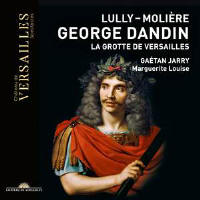Texte paru dans: / Appeared in: |
|
|
Outil de traduction ~ (Très approximatif) |
|
|
Reviewer: Charles
Brewer
Between 1664 and 1666, Louis
XIV had an artificial cave built at his country chateau, Versailles, but
demolished it in 1684 to allow construction of the north wing. Soon after
its completion, this grotto became the setting for Jean-Baptiste Lully’s
first collaboration with the poet Philippe Quinault, Le Grotte de
Versailles. This “eglogue en musique” was first performed at Versailles in
1667 or 1668 and was still being performed (with some alterations) as late
as 1728 at the Concerts Spirituels.
As a typical divertissement,
it begins with a French overture, followed by songs and dances. The center
point of the eclogue is the entry of Daphnis and the Nymphs, who were joined
in the dance by Louis himself, and it concludes with an extended “echo”
chorus and dance. This is the second complete recording I know; the earlier
was by Hugo Reyne with La Simphonie du Marais (Accord 461811, 2001). Both
reflect a sensitivity to the nuances of the French style, though the soloist
for Iris in 2001 seems more comfortable with the intricate ornamentation
written in the manuscript for the second verse of her lament. Unfortunately,
the musettes mentioned in an original libretto are missing in both
recordings, both of which attempt to recreate the original performance.
Molière’s “comedie en musique”, George Dandin, was first performed at
Versailles on 18 July 1668 with Lully’s incidental music. This
divertissement was just one part of an extensive evening’s festivity,
incorporating appetizers, wandering through the gardens, the play in a
specially constructed outdoor theater, a large dinner followed by dancing
and fireworks. The plot follows the plight of the rich peasant, George
Dandin, and his unfaithful wife, and the libretto was conceived “in
the manner of an improvisation” with inserted interludes that form a
miniature pastoral. These are now missing from most modern editions of
Molière’s play, but this recording includes both the music that preceded the
play, the two interludes between the three acts, and the final
divertissement with its concluding double-chorus dialog between the
followers of Bacchus and Love. | |
|
|
|
|
Cliquez l'un ou l'autre
bouton pour découvrir bien d'autres critiques de CD |
|




